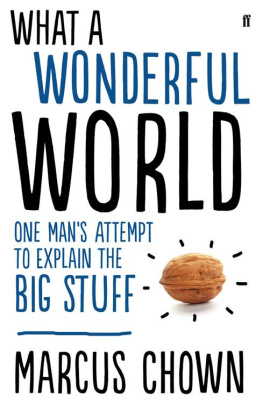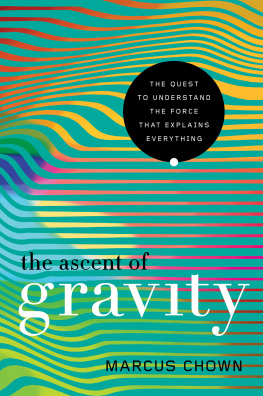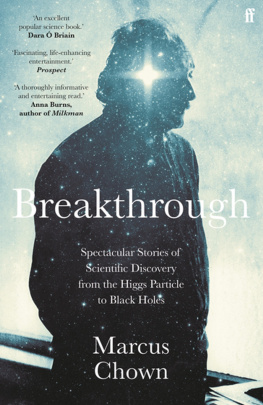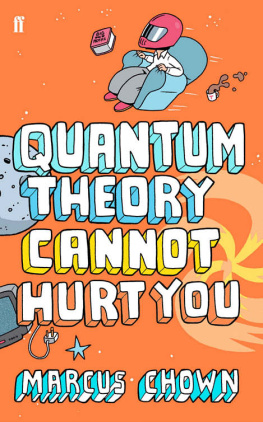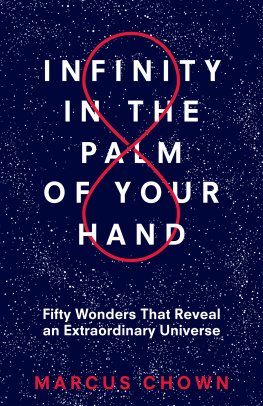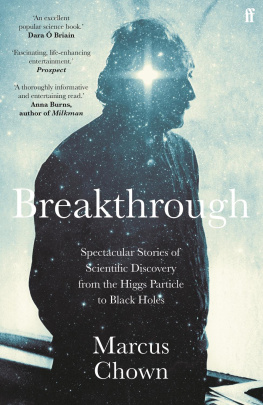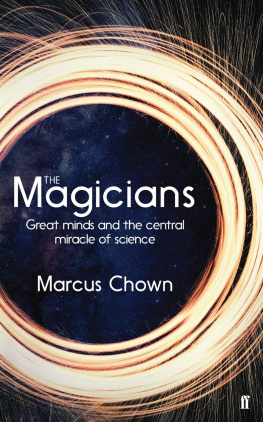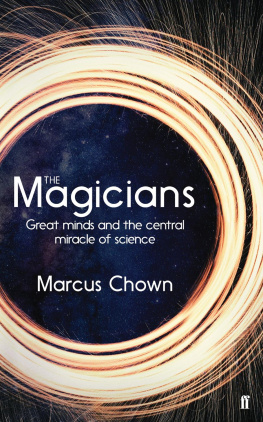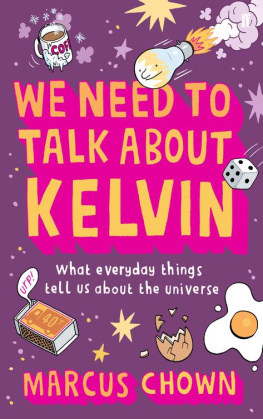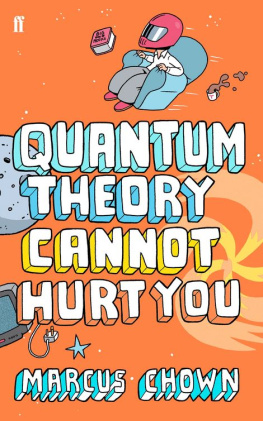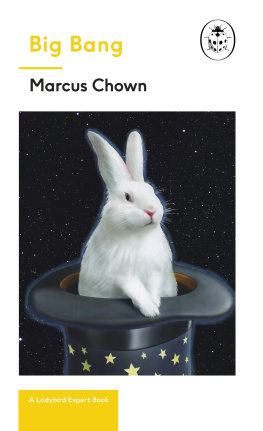To Jeanette, Karen & Aline. So glad I found you. With love, Marcus
This book came about because I have an exceptional editor Neil Belton. In fact, I am his stalker. I have pursued him all the way from Jonathan Cape to Faber. Neil has many talents. But one of those talents is that he knows what his authors are good at and what they should be writing better than they do.
My skill is that I can take complex physics and explain it to someone on a number 25 bus (or perhaps I should say someone unfortunate enough to be sitting next to me on a number 25 bus). But, in addition to physics, I am also interested in other things. I read a lot of fiction. I am interested in history. I like running. In fact, in 2012, I did the London Marathon (something I rarely fail to mention in the first three minutes of meeting someone).
Neils big idea was that I combine these two things: that I use my skill at explaining complex physics in laypersons terms to explain everything in laypersons terms.
I was daunted. How could I possibly write about everything? Where would I even start? I began thinking about how to organise such a wide range of material logically. But I tore up outline after outline. What changed everything, however, was writing Solar System for iPad. I had only 9 weeks to write 120 stories about planets, moons, asteroids and comets, so I had no option but simply to dive in and learn to swim on the job. It must have worked because the App won several awards. So that is what I did. I overcame my apprehension and just dived in.
It was a struggle. Usually, when I need to know something about physics, I identify a physicist it could be a Nobel Prizewinner and simply phone them. There is a 95 per cent chance they will be able to answer my stupid questions immediately. And, if they cannot, they will at least make an attempt at answering them. But, with subjects I knew nothing about, such as money, sex and the human brain, it was difficult even to identify someone who might be able to answer my incredibly basic questions. And, when I did and phoned them, they were often not able to explain things at the toddler level I needed. Worse, it was sometimes as if we were speaking different languages. Often, I had to go to two, three or four people before I could find someone who could answer all my questions. And, on occasion, I could not find anyone who was able to do that. Instead, I was forced to piece together an explanation from things people I had gone to had said and from things I had read.
But Neil was right. This was the book I should have been writing. It was one that stretched me beyond my comfort zone and that, ultimately, proved to be an exhilarating and a joyful experience. I loved learning about all kinds of things I know nothing about. And I began to appreciate what a wonderful world we live in one far more incredible than anything we could possibly have invented. Along the way, I learnt many surprising things, such as
- To understand a single collaterised debt obligation squared one of the toxic investments that sunk the world economy in 2008 would require reading 1 billion pages of documentation
- Slime moulds have 13 sexes (and you think you have problems finding and keeping a partner)
- You could fit the whole human race in the volume of a sugar cube
- You are / mushroom that is, you share / of your DNA with fungi
- You age more slowly on the ground floor of a building than on the top floor
- The crucial advantage that humans had over Neanderthals was sewing
- IBM once predicted that the global market for computers was five
- Today your body will build about 300 billion cells more than there are stars in our Galaxy (no wonder I get knackered doing nothing)
- Believe it or not, the Universe may be a giant hologram. You may be a hologram
If everything in our information-overloaded society has passed you by in a high-speed blur, my book just might bring you quickly and painlessly up to speed on how the world of the twenty-first century works. It is, after all, one mans attempt to understand everything. No, I cannot really claim that. Its one mans attempt to understand everything volume one.
Marcus Chown, London, March 2013
Cells
A good case can be made for our non-existence as entities.
LEWIS THOMAS
Theres someone in my head and its not me.
PINK FLOYD
I think I am me. But I am not. I am a galaxy. In fact, I am a thousand galaxies. There are more cells in my body than there are stars in a thousand Milky Ways. And, of all those myriad cells, not a single one knows who I am or cares. I am not even writing this. The thought was actually a bunch of brain cells neurons sending electrical signals down my spinal cord to another bunch of cells in the muscles of my hand.
Everything I do is the result of the coordinated action of untold trillions upon trillions of cells. I like to think my cells work in my interest, that each breath they draw for me, but perhaps it is they who walk through a park in the early morning, sensing my senses, listening to my music, thinking my thoughts, wrote American biologist Lewis Thomas.
The first step on the road to discovering that each and every one of us is a super-colony of cells was the discovery of the cell itself. Credit for this goes to Dutch linen merchant Antonie van Leeuwenhoek. Aided by a tiny magnifying glass he had adapted from one used to check the fibre density of fabrics, he became the first person in history to see a living cell. In a letter published in April 1673 in the Philosophical Transactions of the Royal Society of London, van Leeuwenhoek wrote, I have observd taking some blood out of my hand that it consists of small round globuls.
The term cell had actually been coined two decades earlier by the English scientist Robert Hooke. In 1655, he had examined plant tissue and noticed dead compartments stacked together. However, neither he nor van Leeuwenhoek realised that cells are the Lego bricks of life. But that is what they are. A cell is the biological atom. There is no life as far as we know except cellular life.
Prokaryotes: a protected micro-universe
The first evidence of cells comes from fossils about 3.5 billion years old. But there is more tentative evidence, from about 3.8 billion years ago, in the shape of telltale chemical imbalances in rocks that are characteristic of living things. The first cells, known as prokaryotes, were essentially just tiny transparent bags of gloop less than a thousandth of a millimetre across. The bag, by concentrating stuff inside, speeded up key chemical reactions such as those that generate energy. It also protected proteins and other fragile products of those reactions from toxic substances such as acids and salt in the environment. The bag of gloop was an island haven in an ocean of disorder and chaos, a protected micro-universe where order and complexity might safely grow.
The complexity of such cells was in large part due to the proteins megamolecules assembled from amino-acid building blocks and made of millions of atoms. Depending on their shape and chemical properties, these Swiss-army-knife molecules can carry out a myriad tasks, from speeding up chemical reactions to acting as cellular scaffolding to flexing like coiled springs to power the movement of cells. Even a simple bacterium possesses about four thousand different proteins, though some proteins, such as those needed for reproduction, are assembled, or expressed, only intermittently. The structure of these proteins is encoded by deoxyribonucleic acid, or DNA, a double-helical molecule floating freely as a loop in the chemical soup, or cytoplasm, inside a cell.

